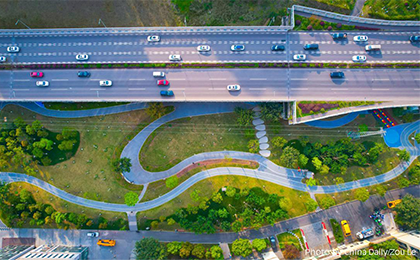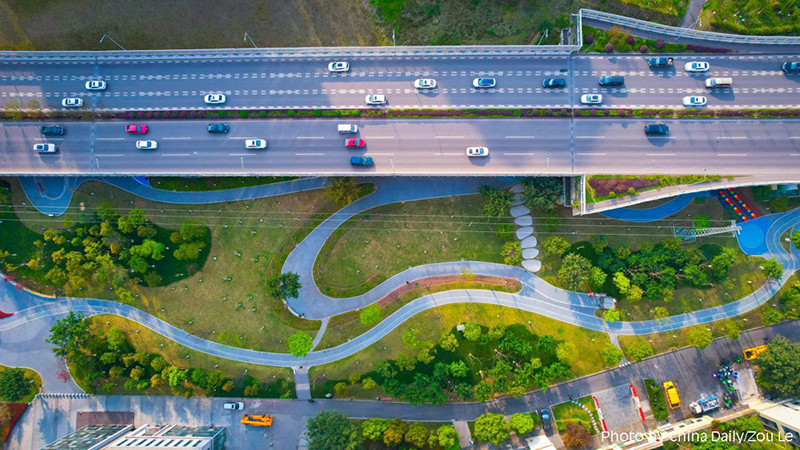



▲ An aerial view of the public space under an overpass in Chongqing's Yubei district. [China Daily/ Zou Le]
3. Design and Construction.
3.3 Road pavement.
(1) Pavement materials.
Pavement materials should meet requirements for smoothness, slip resistance, durability, aesthetics, and ease of maintenance. Avoid using smooth stone, glass, large-gap tiles, and loose materials.
It is advisable to implement the concept of sponge city construction, using permeable and breathable paving to prevent waterlogging.
(2) Vertical design.
Park roads should be designed with safe and comfortable slopes, ideally between 0.3% and 3%.
Roads and activity venues should meet barrier-free design requirements to accommodate special needs.
(3) Layout design.
The walking or running roads should be designed in a closed-loop form, and the road's surface should be continuous and smooth, with a preference for non-slop, breathable, and wear-resistant materials.
Different colors, materials, and patterns can be used to enhance the identification and artistic appeal of the park roads.
Manhole covers and surrounding pavement should be designed in an integrated manner to ensure a smooth surface.
Areas designated as emergency evacuation and rescue routes should comply with relevant standards and regulations.
3.4 Green planning.
(1) Plant selection.
Adhere to the principle of choosing the right tree for the right place, prioritizing local species and adding foliage and flowering plants to create a colorful effect, and selecting regional new varieties as appropriate.
It is preferable to choose plants with no berries or secretions falling to the ground, no thorns, no irritating in smell, no flotsam, no flying catkins, have few pests and are unlikely to cause allergies. Plants with health and therapeutic benefits can be chosen appropriately.
Ground cover should be resistant to trampling, easy to grow, and low maintenance.
Avoid planting tall, fast-growing trees near residential areas to prevent obstructing sunlight. If it is necessary to plant trees, deciduous and slow-growing species are preferred.
(2) Plant landscaping.
Fully respect and utilize existing vegetation on the site, especially the tall trees.
The combination of tree species should focus on providing shade and seasonal characteristics, using colorful foliage, flowering, and fruit-bearing plants to enhance landscape diversity; it may be appropriate to use aromatic plants.
Increase the proportion of "tree-grass" planting structures, leave more ground cover space, and improve transparency.
Promote natural plant configuration and reduce the application of shaped color block plants.
3.5 Landscape furniture.
(1) Landscape buildings (structures).
The cultural theme, scale, style, materials, and colors of landscape buildings (structures) should be coordinated with the overall environment.
The size of pergolas should be proportionate to the site scale, and the design should be combined with the functional needs, cultural themes, and landscape characteristics of the pocket parks. The roofs of the pergolas can be made opaque.
The design of landscape walls should meet the functional and spatial organizational needs, avoiding an excessive number of independent landscape walls.
Design and construct water features like fountains, misting systems, and water landscape walls with full consideration of maintenance, following principles of appropriate use, recycling, and saving to ensure safe contact.
(2) Outdoor tables and seating.
Seat design should be in line with ergonomic requirements, using durable and comfortable materials to improve comfort in both summer and winter.
Seating can be integrated with terrain, tree pits, steps, low walls, and paving to create distinctive landscapes. Seating should accommodate 20% to 30% of the capacity of visitors.
Tables and seating for chatting and playing chess should be arranged in shaded areas or under pavilions.
(3) Auxiliary facilities.
The signage system should be clearly defined, simple, bright, and uniformly styled.
The design and selection of lighting facilities should follow the principles of "low-carbon, practical, aesthetically pleasing, and harmoniously styled," installation location and illumination should consider the impact on plants and the surrounding environment. Encourage the use of smart lighting facilities.
Appropriately conceal or beautify facilities like electrical boxes, manhole covers, and fences.
3.6 Cultural presentation.
(1) Integration with cultural resources.
Emphasize the exploration, presentation, and utilization of cultural resources within and outside the site, such as cultural relics, historic buildings, historical districts, ancient and famous trees, historical stories, folk legends, etc. Create cultural presentation spaces suited to local conditions to inherit and promote outstanding traditional Chinese culture.
(2) Presentation forms.
The selection and presentation of cultural elements should match the theme of the pocket park. Use walls, ground surfaces, sculptures, park furniture, and signage as carriers to show cultural themes and highlight the cultural deposit of the park.
(3) Cultural activities.
Carry out a variety of cultural activities in conjunction with community governance work, residents' needs, and regional cultural traditions to enrich the cultural life of the public.
4. Safety Guarantee.
4.1 Safety requirements.
Night lighting should be combined with major park routes, focusing on functional lighting to avoid dark areas. The lighting in the children's activity area should be reflective lamps and lanterns to prevent glare.
Maintain necessary transparent sightlines in green spaces to avoid blind spots that could affect safety management.
Sports and fitness facilities should indicate the age and physical condition limitations, specify operational requirements, and note if supervision is needed.
Children's activity areas should not be adjacent to motorways, bike lanes, or parking lots. Accessible water areas should not use high-pressure fountains.
The surfaces of landscape furniture should be smooth, with rounded edges or corners to avoid safety risks.
Intelligent monitoring and management facilities are desirable.
All facilities in the park should comply with relevant safety standards and regulations.
4.2 Accessibility requirements.
The design and construction of barrier-free facilities such as curb ramps, wheelchair ramps, handrails, etc. should comply with relative standards. Connections between entrances, park roads, and building facilities should be smooth and non-slip, ensuring a continuous and accessible route. A complete accessibility signage system should be established, with facilities such as voice services and Braille signs where appropriate.
Source:
<https://www.gov.cn/zhengce/zhengceku/202406/content_6959879.htm>
<https://mp.weixin.qq.com/s/7rDoAKkk00qa5a5M86HFCA>
Editor & Translator: GUO Xinxin